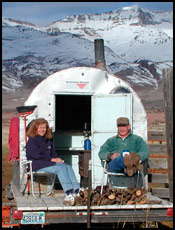
Ron Torell with his wife, Jackie.
Cow Camp Chatter
Bovine grass fever
It happens to cows in mid-April of every year in high-mountain hay-feeding country. Bovine grass fever. Cows will leave dry hay on the feed ground, preferring to chase a tint of green. We certainly cannot blame the cow for her interest in chasing green grass over dry hay. Cows are tired of eating dry hay, and cowboys are tired of feeding it. The promise of green grass is a welcome sight to all.
Managers frustrated over wasted hay give up and turn cows out. In the cow's quest to meet her dietary protein, energy, vitamin and mineral needs, she'll leave the lower-quality hay on the feed ground in favor of a very palatable grass, which is high in protein yet generally short in quantity and energy content during this time period.
The tint of green in early spring is no more than a promise of the quality of grass to come. It is inadequate in quantity to meet a cow's elevated postpartum nutritional needs. This results in declining body condition at the most crucial stage, the anestrous postpartum interval. This is the period from calving to first estrus. In addition to the trauma of calving, the uterus is going through an involution process, which is necessary to prepare the cow for rebreeding within 83 days, ensuring she will calve at the same time next year. Peak lactation is occurring, and many of these cows are thin from the past several months of winter-feeding or lack thereof.
Most ranchers recognize that cows are slipping a bit during this early grass green-up period, but feel they'll catch up with compensatory gain once the grass catches up. This is partially true. Reduced nutritional levels may result in an extended postpartum interval or open cows, especially with the young and those animals coming out of the winter in poor body condition. Postcalving energy — along with protein, vitamins and minerals — is very important to pregnancy rates. One method of compensation is maintaining adequate at-calving body condition scores of 5 for mature cows and 6 for first-calf heifers. This reinforces the assertion that you cannot starve the profit out of a cow, especially in the last trimester of pregnancy and postpartum.
Of the four biological periods of the beef cow's cycle, the last trimester of pregnancy is the second-highest in nutrient demand, surpassed only by the postpartum period. What a manager has done or failed to do for the cow nutritionally throughout the entire year, especially during the winter-feeding period to preserve body condition, will affect calf survival rate, postpartum interval and breed back. By winter-stockpiling and preservation of energy in the form of fat on the cow's back there is a savings account to draw from during the anticipated grass fever period. This requires advanced planning and a preventative and proactive management program.
For the most part, May and June calving regimens will solve the grass fever vs. nutrient demand problem. By calving later, a cow's nutritional peak is better matched to the nutritional supply of quality and quantity of grass. March-calving cows are at a disadvantage for they are 30 to 40 days postcalving during mid-April grass green-up and at their peak nutritional demand. This generally results in an extended anestrous postpartum interval. With the obvious pointed out, there are readers who must calve their cows in March for various management, resource and logistical reasons, including "because it was the way Grandpa and Dad did it."
A sound management practice to follow is to reserve the very best hay on the ranch for this grass fever period when the cow's nutritional requirements are at their highest. If the very best hay you have is not enough to out-compete the tint of green, consider supplementation. The supplement of choice would have to be nutrient-dense yet very palatable and include vitamins and minerals. Products such as distillers' grain, range cubes, tubs, blocks or liquid supplements could help fill the void. Whatever product is used, it must be equally or more palatable and enticing to the cow's taste buds as the grass is. Managers should certainly put a pencil to a supplementation strategy weighing any gains in breed-back to profitability.
Many ranchers have implemented range management efforts such as planting early-maturing vegetation (both shrubs and grasses) that can fill the void between winter-feeding and perennial grass green-up and maturity. Crested wheat grass is one example of the first green-up in the west. Historically, early and hard extended use of perennial grasses during the April grass fever period often results in a decline and change of vegetation type on many rangelands. As a method of preventing this deterioration of rangelands some ranchers build a secure well-fenced sacrifice area and force animals to eat their daily ration of hay until outside grass is adequate to support their elevated nutritional demand.
Nutrient intake and body energy reserves (body condition) are major regulators of reproductive performance of beef cows. Reduced body weight, which often occurs during the bovine grass fever period, causes cessation or extensions of estrous cycles. Inadequate body condition at calving prolongs the postpartum anestrous interval. As managers, we need to be aware of the consequences bovine grass fever can cause and incorporate a preventative or adjustment factor into our management program.
 That's enough for this month. As always, if you would like to discuss this article or simply want to talk cows, do not hesitate to contact me at 775-385-7665 or e-mail me.
That's enough for this month. As always, if you would like to discuss this article or simply want to talk cows, do not hesitate to contact me at 775-385-7665 or e-mail me.
[Click here to go to the top of the page.]










